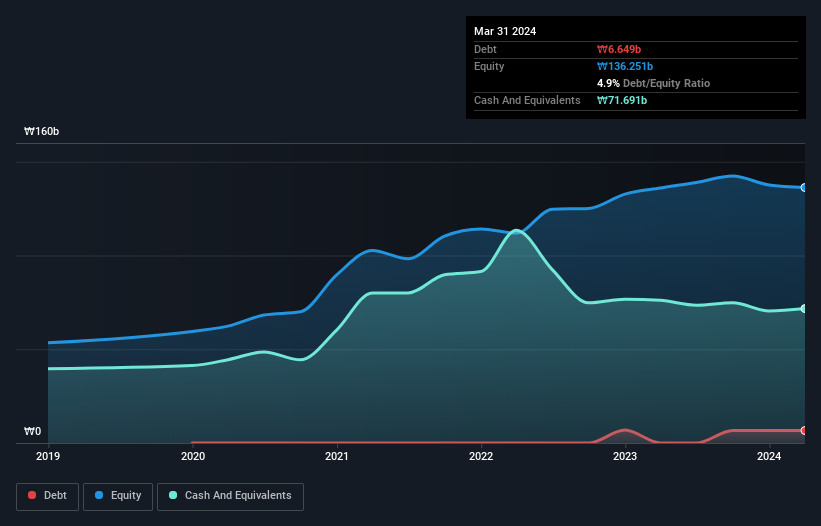- South Korea
- /
- Semiconductors
- /
- KOSDAQ:A089970
Health Check: How Prudently Does VM (KOSDAQ:089970) Use Debt?
David Iben put it well when he said, 'Volatility is not a risk we care about. What we care about is avoiding the permanent loss of capital.' So it seems the smart money knows that debt - which is usually involved in bankruptcies - is a very important factor, when you assess how risky a company is. As with many other companies VM Inc. (KOSDAQ:089970) makes use of debt. But the real question is whether this debt is making the company risky.
When Is Debt Dangerous?
Debt is a tool to help businesses grow, but if a business is incapable of paying off its lenders, then it exists at their mercy. Part and parcel of capitalism is the process of 'creative destruction' where failed businesses are mercilessly liquidated by their bankers. However, a more common (but still painful) scenario is that it has to raise new equity capital at a low price, thus permanently diluting shareholders. Of course, plenty of companies use debt to fund growth, without any negative consequences. The first step when considering a company's debt levels is to consider its cash and debt together.
Check out our latest analysis for VM
What Is VM's Debt?
You can click the graphic below for the historical numbers, but it shows that as of March 2024 VM had ₩6.65b of debt, an increase on none, over one year. However, it does have ₩71.7b in cash offsetting this, leading to net cash of ₩65.0b.

How Healthy Is VM's Balance Sheet?
Zooming in on the latest balance sheet data, we can see that VM had liabilities of ₩15.3b due within 12 months and liabilities of ₩1.85b due beyond that. Offsetting this, it had ₩71.7b in cash and ₩1.40b in receivables that were due within 12 months. So it actually has ₩56.0b more liquid assets than total liabilities.
This excess liquidity suggests that VM is taking a careful approach to debt. Because it has plenty of assets, it is unlikely to have trouble with its lenders. Succinctly put, VM boasts net cash, so it's fair to say it does not have a heavy debt load! When analysing debt levels, the balance sheet is the obvious place to start. But ultimately the future profitability of the business will decide if VM can strengthen its balance sheet over time. So if you want to see what the professionals think, you might find this free report on analyst profit forecasts to be interesting.
Over 12 months, VM made a loss at the EBIT level, and saw its revenue drop to ₩23b, which is a fall of 71%. To be frank that doesn't bode well.
So How Risky Is VM?
We have no doubt that loss making companies are, in general, riskier than profitable ones. And in the last year VM had an earnings before interest and tax (EBIT) loss, truth be told. Indeed, in that time it burnt through ₩16b of cash and made a loss of ₩12b. Given it only has net cash of ₩65.0b, the company may need to raise more capital if it doesn't reach break-even soon. Even though its balance sheet seems sufficiently liquid, debt always makes us a little nervous if a company doesn't produce free cash flow regularly. There's no doubt that we learn most about debt from the balance sheet. However, not all investment risk resides within the balance sheet - far from it. For example - VM has 2 warning signs we think you should be aware of.
At the end of the day, it's often better to focus on companies that are free from net debt. You can access our special list of such companies (all with a track record of profit growth). It's free.
New: Manage All Your Stock Portfolios in One Place
We've created the ultimate portfolio companion for stock investors, and it's free.
• Connect an unlimited number of Portfolios and see your total in one currency
• Be alerted to new Warning Signs or Risks via email or mobile
• Track the Fair Value of your stocks
Have feedback on this article? Concerned about the content? Get in touch with us directly. Alternatively, email editorial-team (at) simplywallst.com.
This article by Simply Wall St is general in nature. We provide commentary based on historical data and analyst forecasts only using an unbiased methodology and our articles are not intended to be financial advice. It does not constitute a recommendation to buy or sell any stock, and does not take account of your objectives, or your financial situation. We aim to bring you long-term focused analysis driven by fundamental data. Note that our analysis may not factor in the latest price-sensitive company announcements or qualitative material. Simply Wall St has no position in any stocks mentioned.
About KOSDAQ:A089970
VM
Manufactures and sells dry etcher systems that are used for semiconductor production process in South Korea and internationally.
Flawless balance sheet with low risk.
Market Insights
Community Narratives




